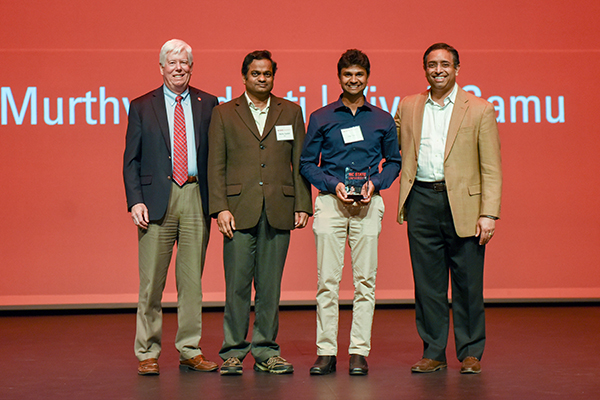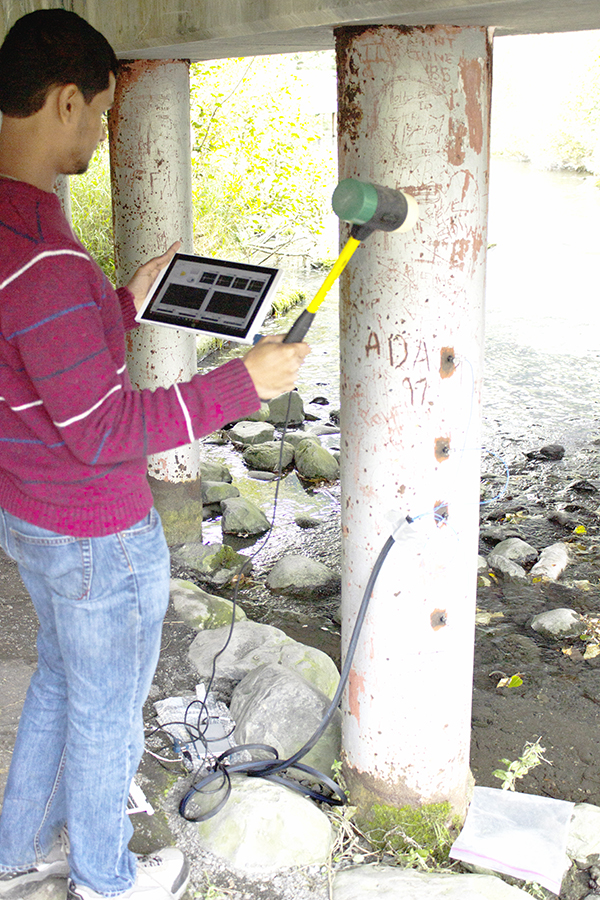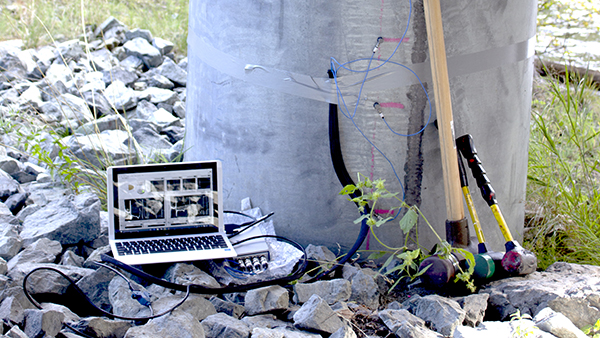New technology making waves in infrastructure, health care

Humans use sound to see where our eyes can’t — like when you’re putting up a shelf and tap the wall to find the studs.
Those sounds, traveling through waves, answer questions — is this where the stud is, or is this just drywall? Over the years, technologies like ultrasound have used these sound waves to produce images of things we’d never been able to see before.
Now, researchers at NC State and Mayo Clinic are developing algorithms and technologies that allow us to see even more clearly through sound.
CCEE professor Dr. Murthy Guddati is leading research to develop more accurate, less invasive methods that have applications in infrastructure and human health. His technology that is furthest along more accurately measures bridge pile foundation depths, and he is exploring testing methods for evaluating pavement damage, profiling soil layers and detecting oil reservoirs. He is also working with biomedical researchers on more accurate health care diagnostic techniques, including one that measures stiffness in arteries, an early indicator of heart disease.
Guddati, who earned his master’s degree in civil engineering and Ph.D. in computational and applied mathematics, has a strong background in theoretical concepts, which puts him in a unique position to help investigate some of these problems. His research has been collaborative, supported by organizations including the National Science Foundation, Alaska and North Carolina Departments of Transportation (DOT), the National Institutes of Health (NIH) and Mayo Clinic.
“This wouldn’t have been possible if I had not paid attention to all the math and physics,” he said. “If I just jumped on these problems without developing the deep understanding, I don’t think I would have made as much of a difference.”
Accurately assessing infrastructure
One day, Guddati was speaking with a colleague about the longstanding problem of estimating the depth of pile foundations of aging bridges, many of which were lacking records. Pile foundations are slender columns that extend several yards into the ground to transfer the weight of the vehicles and the bridge into the soil.
“I thought, ‘OK, this is something that can be converted to a simple mathematical problem,’” Guddati said. “’So maybe there is a simple solution.’”
From this work came Effective Dispersion Analysis of Reflections, or EDAR, which is a novel, nondestructive evaluation technique that helps estimate the embedded depth of pile foundations. It works by tapping the bridge pile with a hammer and then measuring the acceleration of the returning waves at two places to calculate the depth from which they are reflecting.

Guddati’s master’s student Vivek Samu took on the project for his thesis. Samu, who has since graduated with a Ph.D. and now works as a postdoctoral researcher, started with computer simulations, then tested the technique on a model bridge pile another CCEE faculty member had in the Constructed Facilities Lab. Samu and Guddati thought more lab testing would be needed, but their results were better than imagined, so they moved to field testing, working with two state DOTs.
Initially in the field, they ran into some issues because the waves coming back up were different from what they anticipated, which they realized was because the soil conditions were different than they were in the lab. Eventually, they were able to estimate the pile length within a 10 percent margin of error.
“Currently, we have a very promising technology that has the potential to be developed into a product,” Samu said.

Working with NC State’s Office of Research Commercialization (ORC), Guddati and Samu have patented the EDAR methodology and created the startup INDTI, Innovative Nondestructive Testing of Infrastructure. ORC has helped with navigating the patent process, developing business plans and raising funds.
Long term, their goal for INDTI is to provide non-destructive testing methods that can be used not just for bridge pile foundations, but to characterize all kinds of infrastructure. One such technology in development measures pavement deterioration. The plan is to expand to wide-ranging applications for aging infrastructure and translate them into commercial products.

Improving health care diagnostics
After the initial success in infrastructure, Guddati started to consider how the technology could be used in other fields, including health care, where more accurate, less invasive diagnostic tests can improve patient care.
Working with Tuhin Roy, former Ph.D. student and current postdoctoral researcher at NC State, and Matthew Urban, associate professor and researcher at Mayo Clinic in Rochester, Minn., Guddati received funding from the NIH to develop and test a technology that uses shear wave elastography (SWE) to measure arterial stiffness, which may be an indicator of cardiovascular disease.
“The core principle behind the SWE has been employed in geotechnical and other related fields for over a decade,” Roy said. “And now we are using similar ideas here in the biomedical field.”
The technology uses the same ultrasound machines already in hospitals, and Mayo Clinic has a unique technology to excite the carotid artery with sound waves. The ultrasound transducer sends a wave that pushes against the arterial walls and records the wave propagation. These movements are tiny, on the order of 1 to 20 micrometers, and the propagating waves are run through an algorithm that determines the stiffness of the arterial wall.
“In general, the ultrasound scanners have the hardware to do the same measurements that we’re performing, but not necessarily the software or the methodologies behind it,” Urban said. “It’s the things under the hood that we are working on so that we can actually get better estimates of arterial mechanical properties, in this case.”
While measuring arterial stiffness is the furthest along, with Mayo Clinic testing the technology in studies involving human subjects, Guddati and Urban are evaluating other diagnostics that could benefit from SWE.
Elastography methods are already used to evaluate tumor and liver stiffness, but the new methods the researchers are developing could improve diagnostic accuracy in evaluating if tumors are cancerous or in early detection of cirrhosis. Researchers are also developing a way to estimate red blood cell content in blood clots in the brain, which can help determine the best way to remove the clot. These applications are still in the early stages of testing.
Because Mayo Clinic does not have an engineering school, the partnership with NC State has been beneficial for both parties. Physicians and scientists have been receptive to these methods — which are not so different from what they currently use, just more accurate.
“When you solve a real problem, you affect lives,” Guddati said. “The solutions that we provided are not necessarily complicated. But they were impactful and novel.”
This story was originally published by NC State’s College of Engineering.
- Categories: